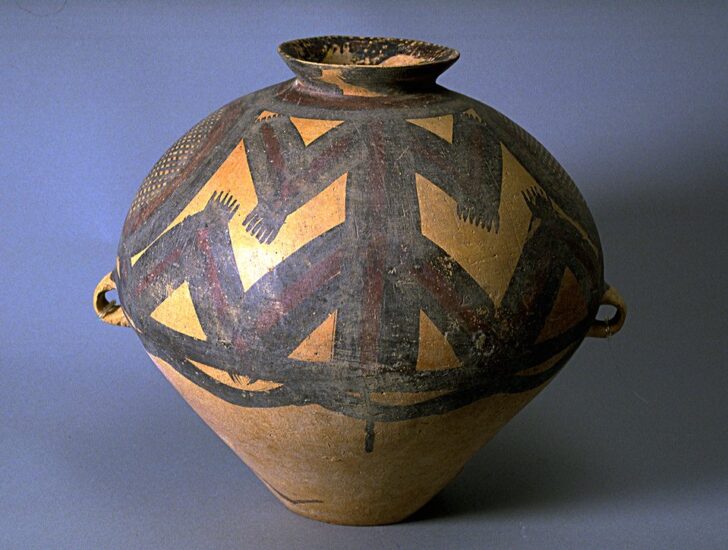Jar
Chinese

Description
Subject Matter:
A mortuary urn or guan (罐) jar of the Neolithic Machang phase (2300–2000 BCE) of Majiayao Culture from Machang, Gansu of the Yellow River Valley in northwestern China. Discovered by Johan Gunnar Andersson in 1921, by the 1980s approximately 60,000 items and 400 kilns had been discovered at Majiayao sites (He Li 1996, 22). They were found in subterranean graves with conical bases placed into the local loess soil, and because the decoration is consistently only on the top portion of the jar, it can be assumed they were meant to be viewed from above. While it is impossible to know the meaning behind this decoration, researchers suggest perhaps the zigzag pattern represents a zoo-morphic figure with the fringed finger-like protusions. They interpret the network patterns within the circles to represent fishing nets and a major source of food supplied by the Yellow River. The two lug handles were probably used to tie down a wooden, or other decomposable material, lid.
This type of guan is extraordinarily thin and lightweight. Constructed by using the coiling method, they were then paddled and scraped thin, covered in a fine slip then painted with mineral pigments before being fired in small, simple updraft kilns. The mineral pigments consisted of iron and manganese oxides to give red, brown and black hues. These jars were all made with similar proportions, which suggests the use of a mathematical module, standardization, assembly line style mass production and the possible division of labor during the Neolithic period (Poor 1995, 166).
References:
He, Li. Chinese Ceramics: a New Comprehensive Survey From the Asian Art Museum of San Francisco. New York: Rizzoli, 1996.
Poor, Robert. "The Circle and the Square: Measure and Ritual in Ancient China" Monument Serica 43 (1995), 159-210.
Physical Description:
A light reddish-buff earthenware guan (罐) jar with a wide globular upper body and conical lower body on a narrow flat base, and a tall narrow neck with everted rim. There are two diametrically opposed lug handles at the waist. The upper half of the body is painted with black and red pigments to depict two concentric circles on opposing sides. The circles contain network patterns, separating two main motifs of zigzags divided by a central vertical line. Six or seven thin lines extend from each of the points, confined between solid band borders, with a lobed line border below. Around the neck are bold, thick, black, slightly curving brush strokes.
Usage Rights:
If you are interested in using an image for a publication, please visit https://umma.umich.edu/request-image/ for more information and to fill out the online Image Rights and Reproductions Request Form.